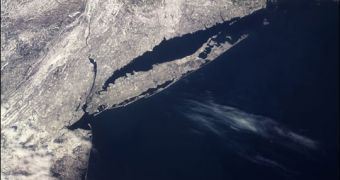A group of scientists from the Harvard University led by Katherine Cagen claims that a massive tsunami wave splashed ashore some 2,300 years ago, mightily sweeping the coastal regions of New York deeply inland. Even more, the researchers indicate it is most likely that the catastrophe was caused by an ancient asteroid crashing somewhere in New Jersey's continental shelf. The pieces of evidence they have to support their claims are still not clear enough in order to convince the skeptics, though.
At the time the asteroid struck, the region was far more quiet and looked very differently, with empty beaches in New Jersey and Long Island and large forests covering Manhattan. Then, the 100 meters (330 feet) across asteroid changed all that. The team of specialists found clues to that happening in carbon spherules (perfectly spherical granules that are the result of high pressures of massive collisions).
"But the main thing that closes the deal is that we looked in the spherules and found nano-diamonds," explained Dallas Abbott, a study participant from Columbia University, for Discovery. "These have only been found in impact ejecta or in meteorites." Referring to the tsunami, Steven Ward from the University of California shared that, in order "To get a wave 2.5 meters high that far up the Hudson, you need a wave 20 meters high at Manhattan. It would've gone several hundred meters inland on Long Island; you should see evidence of this thing all over the place".
Still, the researchers indicate that it's very hard to distinguish between sediments carried by such a mammoth wave and those carried by powerful storms. It remains for the central piece of evidence to be found – the one that would prove their theory beyond doubt to the many skeptics – the impact crater, which they think must be located somewhere off New Jersey's shelf. "We're making the pretty outrageous claim that not only did a tsunami hit the New York metropolitan area 2,300 years ago, but it was caused by an asteroid impact for which we can't find a crater," stated Cagen.

 14 DAY TRIAL //
14 DAY TRIAL //